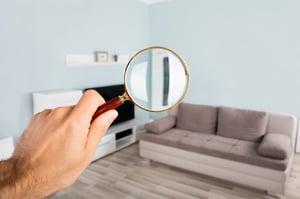 No one wants to be faced with an unpleasant surprise when a resident moves out. Unfortunately, interior inspections, which keep owners apprised of the state of their rental property, are often neglected. Why is it so important to do these on a regular basis? This inspection works hand-in-hand with other safeguards to be sure that your property is being maintained to your standards.
No one wants to be faced with an unpleasant surprise when a resident moves out. Unfortunately, interior inspections, which keep owners apprised of the state of their rental property, are often neglected. Why is it so important to do these on a regular basis? This inspection works hand-in-hand with other safeguards to be sure that your property is being maintained to your standards.
When new residents move into a rental home, it’s crucial to conduct an exterior inspection and a move-in walkthrough. It protects you and the resident by providing proof of the property’s condition at hand-off. Interior inspections are measured against the move-in checklist and must be completed regularly after move-in to ensure the residents are taking care of the property.
The exterior inspection looks at the landscaping, rear and side yards, driveway maintenance, and other outside items, and can often provide clues that an interior inspection, which focuses on everything you see once you cross the threshold, may be necessary. However, even if the exterior of a property is pristine, it’s still important to periodically check the interior.
Move-In Walkthroughs vs. Interior Inspections
While similar, interior inspections and move-in walkthroughs are not the same. Move-in walkthroughs are very detailed and time-consuming inventories of the condition of the property’s interior when the keys are handed over to the resident. Interior inspections are follow-ups to those walkthroughs and ensure everything is being maintained properly by the resident. While both do use the same checklist, interior inspections are more about the overall maintenance of the property, so they are completed more quickly than move-in walkthroughs.
Interior Inspection Ratings
You should go through the residence room by room with your checklist in hand, rating each area. If something needs to be fixed, record thorough notes, so you can provide clear direction to the resident about what needs to be done to get the property back to the condition it was in when they rented it. It’s also important for tracking purposes so you can ensure the property is brought up to par.
Interior Inspection Process
Interior inspections should be performed approximately every four months, although obviously, if you believe there might be an issue, you could accelerate the schedule. In general, here are the rooms and areas that should be inspected during interior inspections:
- Communal spaces and private rooms
Shared areas like dining rooms, living rooms, and entryways, as well as private areas like bedrooms and bathrooms, should be inspected to ensure nothing has been damaged. - Smoke detectors
Pay special attention to all smoke and carbon monoxide detectors to ensure they are still installed in the proper areas and are functioning properly with active batteries. These are important life safety devices that are legally required in all rental properties. City or local jurisdiction inspectors often come to check these devices. If violations are found, owners are typically given seven or fewer days to resolve the issue before facing fines. When you check for these violations during interior inspections, it helps protect you from violating governmental regulations. - Kitchens
As you’d guess, an interior inspection checks items like faucets, cabinets, and counters are operable and undamaged. There’s also an added check for appliance functionality; stoves, ovens, dishwashers, garbage disposals, and microwaves should not be broken. - Laundry rooms
For laundry rooms, be sure to check the plumbing lines, faucets, and valves that connect to the washer and dryer for damage. - Major systems
Examine all the major systems of the home for functionality: furnace, thermostat, air conditioner, and water heater. Check the filter on the air conditioner as well, because a dirty filter can lead to serious—and easily preventable—damage down the road. - Garage
The interior of the garage isn’t typically examined during the exterior inspection, so this is the opportunity to look for any damage.
When performing these inspections, it’s important to remember that you shouldn’t expect the home to look as it did when it was rented. It’s being lived in and things happen. Look for true damage, not expected wear and tear. For example, nothing should be broken or removed.
When you do encounter something that is broken, it’s up to the resident to fix it. Document the issue, notify the resident, give them a timeframe to fix it, follow-up on the due date and bill them if they don’t address the items.
The standard amount of time to replace or fix items is one week. Residents should submit an image of the repaired item, but if they don’t, follow up in person to confirm. These issues can be tracked in the property management system just like a regular work order to ensure they are resolved. If an issue isn’t taken care of within the given timeframe, you’ll have to get a vendor to perform the work, then bill the resident for the cost plus a service fee to cover the additional work that fell on you.
If you’re interested in discovering more about rental property management, learn how to Avoid These 7 Common Mistakes Made When Managing Residential Investment Properties.


